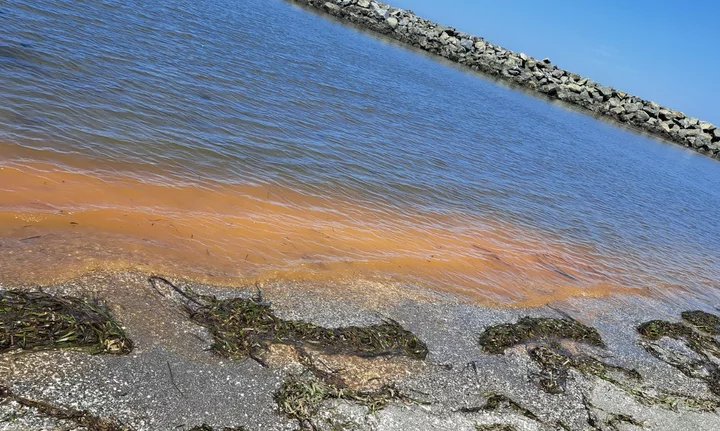Photo: Jeff Erickson
The Humboldt County Department of Health and Human Services gets into the details in the release below:
Local and state environmental health officials confirmed that samples of the orange algal bloom from King Salmon beach that were sent to the North Coast Regional Water Quality Control Board’s laboratory last week were non-toxic dinoflagellate otherwise known as Noctiluca creating a red tide. While it was still visible, officials recommend avoiding direct contact with the water because of potential respiratory irritation or effects to the skin.
As of Tuesday, Aug. 15, the red tide appeared to have subsided, and staff removed the warning signs that had been placed on the beach.
As summer starts to wind down, officials are users of all bodies of fresh water to keep an eye out for and avoid contact with cyanobacteria (also known as blue-green algae). Typically, cyanobacteria warnings come out between late July and early August, coinciding with low flows and sustained high temperatures in the inland areas which may contribute to cyanobacteria growth in the river.
Benjamin Dolf, a Supervising Environmental Health Specialist with the Humboldt County Department of Health & Human Services Environmental Health Division (DEH), said that visual indicators are key to identifying areas impacted by harmful algal blooms. In lagoons and still water they can appear in a variety of colors and may look like thick paint floating or small flakes on the water. In rivers and moving water, blooms appear as thick matting on the rocks and river bottom. These mats often detach and accumulate along the shoreline. Citizen surveillance is key, and DEH staff will investigate any potential blooms reported by the public.
Other guidance for bodies of water that meet the danger threshold include the following:
- Do not let pets and other animals drink or go into the water or go near the scum.
- Stay away from scum, and cloudy or discolored water.
- Do not eat fish or shellfish from this water.
- Do not use this water for drinking or cooking. Boiling or filtering will not make the water safe.
Human activities have an impact on nutrient and water flows in rivers, streams and lakes. Nutrients found in fertilizers, animal waste and human waste can stimulate blooms. Excessive water diversions can also increase water temperatures and reduce flows. People can take the following measures to prevent algal blooms in our waters:
- Be conservative with the use of water, fertilizers and pesticides on your lawn, garden or agricultural operation.
- Avoid nutrient runoff by recycling any “spent” soil by tilling it back into gardens or protecting it from rainfall.
- Create shade and filter out nutrients by planting or maintaining native plants around river banks.
- Inspect and pump out septic systems every three to four years.
- Prevent surface water runoff from agricultural and livestock areas.
Cyanobacteria can be present in any fresh water body. It looks like dark green, blue-green, black, orange or brown scum, foam or mats on the riverbed or floating on the water. Warm water and abundant nutrients can cause cyanobacteria to grow more rapidly than usual causing “blooms.”
- Prevent erosion around construction and logging operations.
These blooms are termed “harmful algal blooms.” Most cyanobacteria does not affect animals or people, however, a small number of cyanobacteria species are capable of producing toxins that can be harmful to animals and humans. Dogs and children are most likely to be affected because of their smaller body size and tendency to stay in the water for longer periods of time.
The presence of cyanobacteria has been previously confirmed in some water bodies within Humboldt, Mendocino and Lake counties including the South Fork Eel River, Van Duzen River, Trinity River, Clear Lake and Lake Pillsbury. It is difficult to test and monitor the many lakes and miles of our local rivers. Most blooms in California contain harmless green algae, but it is important to stay safe and avoid contact.
Officials recommend the following guidelines for recreational users of freshwater areas:
- Keep children, pets and livestock from swimming in or drinking water containing algal scums or mats.
- Adults should also avoid wading and swimming in water containing algal blooms. Try not to swallow or inhale water spray in an algal bloom area.
- If no algal scums or mats are visible, you should still carefully watch young children and warn them not to swallow any water.
- Fish should be consumed only after removing the guts and liver and rinsing fillets in tap water.
- Never drink, cook with or wash dishes with water from rivers, streams or lakes.
- Get medical attention immediately if you think that you, your pet, or livestock might have been poisoned by cyanobacteria toxins. Be sure to tell the doctor or veterinarian about possible contact with cyanobacteria or algal blooms.
To learn more about cyanobacteria and harmful algal blooms, visit the state of California’s website at www.mywaterquality.ca.gov/habs/index.html.
- Join or support one of the many watershed and river organizations.
To learn more about cyanobacteria and algae on the South Fork Eel River, visit www.eelriverrecovery.org/algae.html.
To learn more about the impacts harmful algal blooms have on pets, the CalEPA Office of Environmental Health Hazard Assessment has guidance for dog owners here: https://oehha.ca.gov/media/downloads/risk-assessment/fact-sheet/dogownerfactsheet2018.pdf.
To report a bloom, e-mail CyanoHAB.Reports@waterboards.ca.gov or call 844-729-6466 (toll free). Blooms can also be reported via the “bloomWatch” app which is available for free download on iTunes or Google play.
For information on conditions occurring within Humboldt County, contact the Division of Environmental Health at 707-445-6215 or 800-963-9241. Photos of suspected blooms can also be emailed to envhealth@co.humboldt.ca.us.

CLICK TO MANAGE